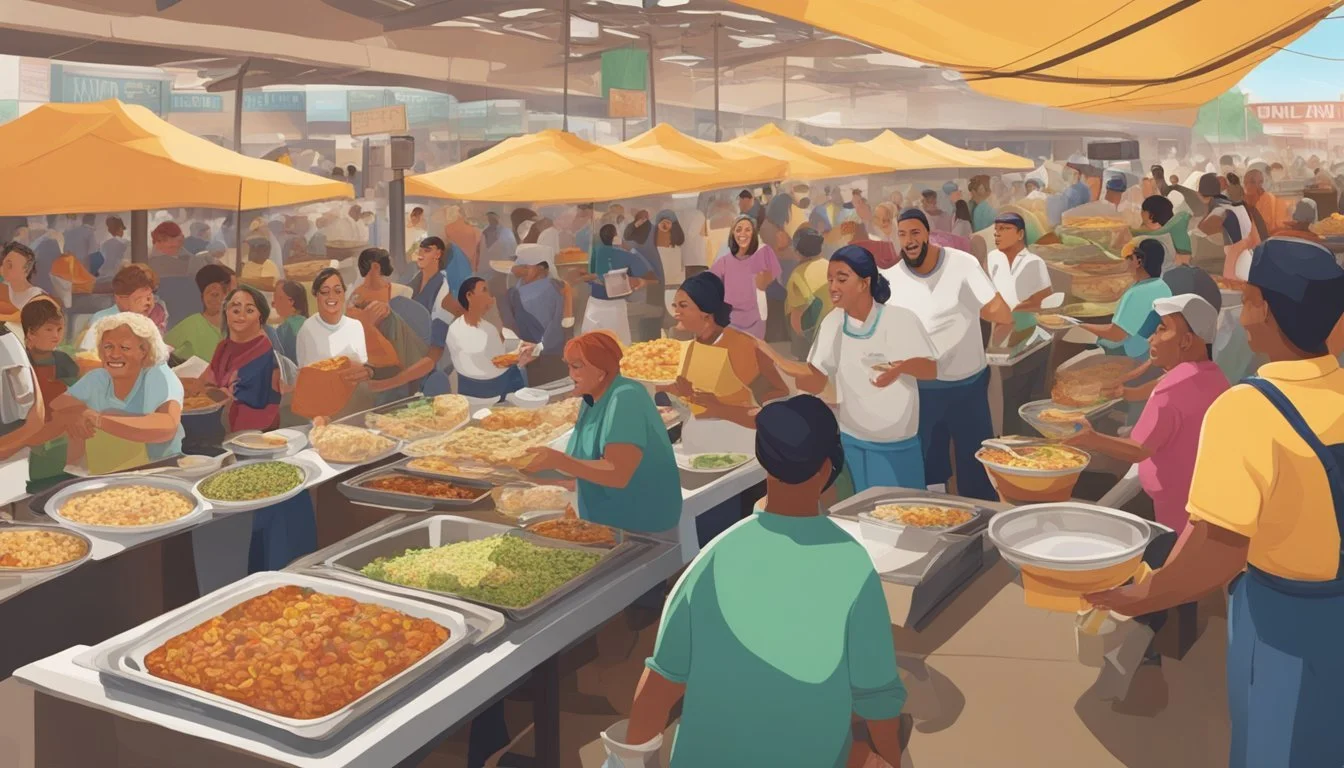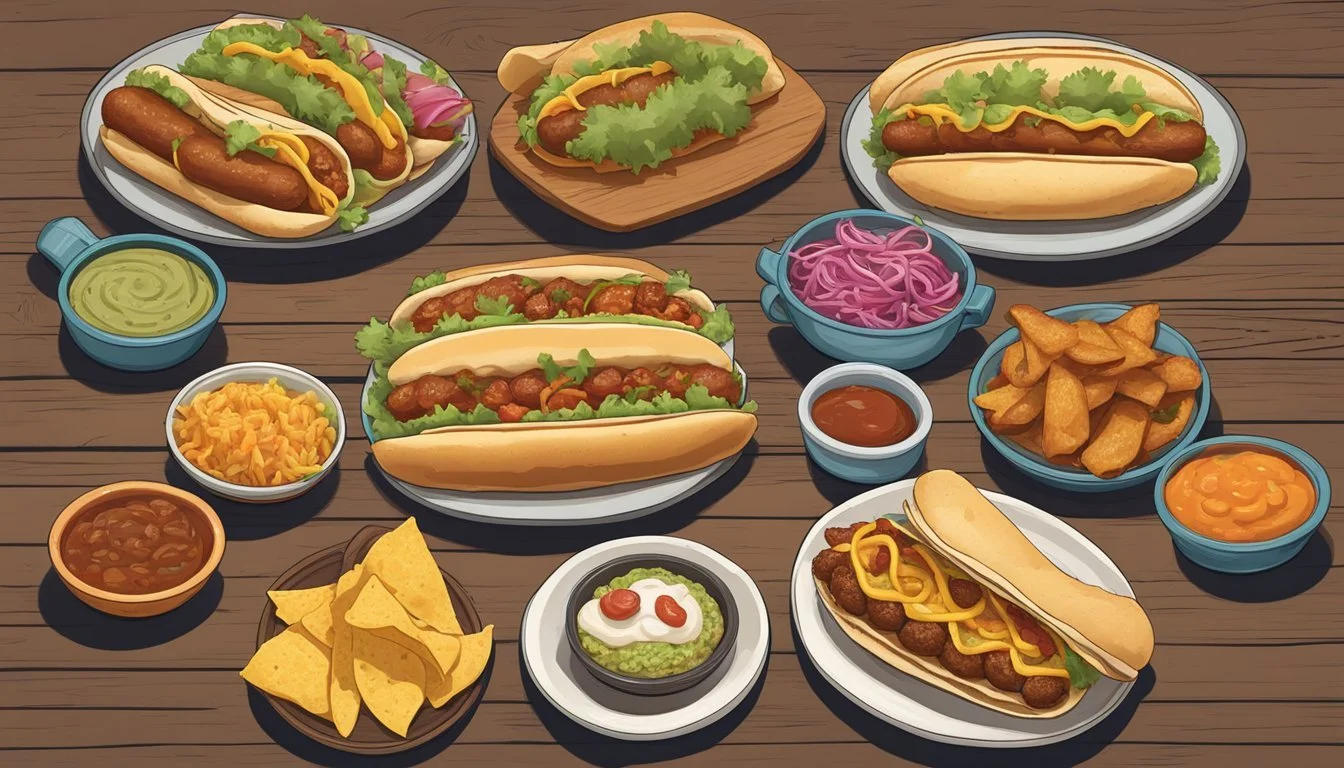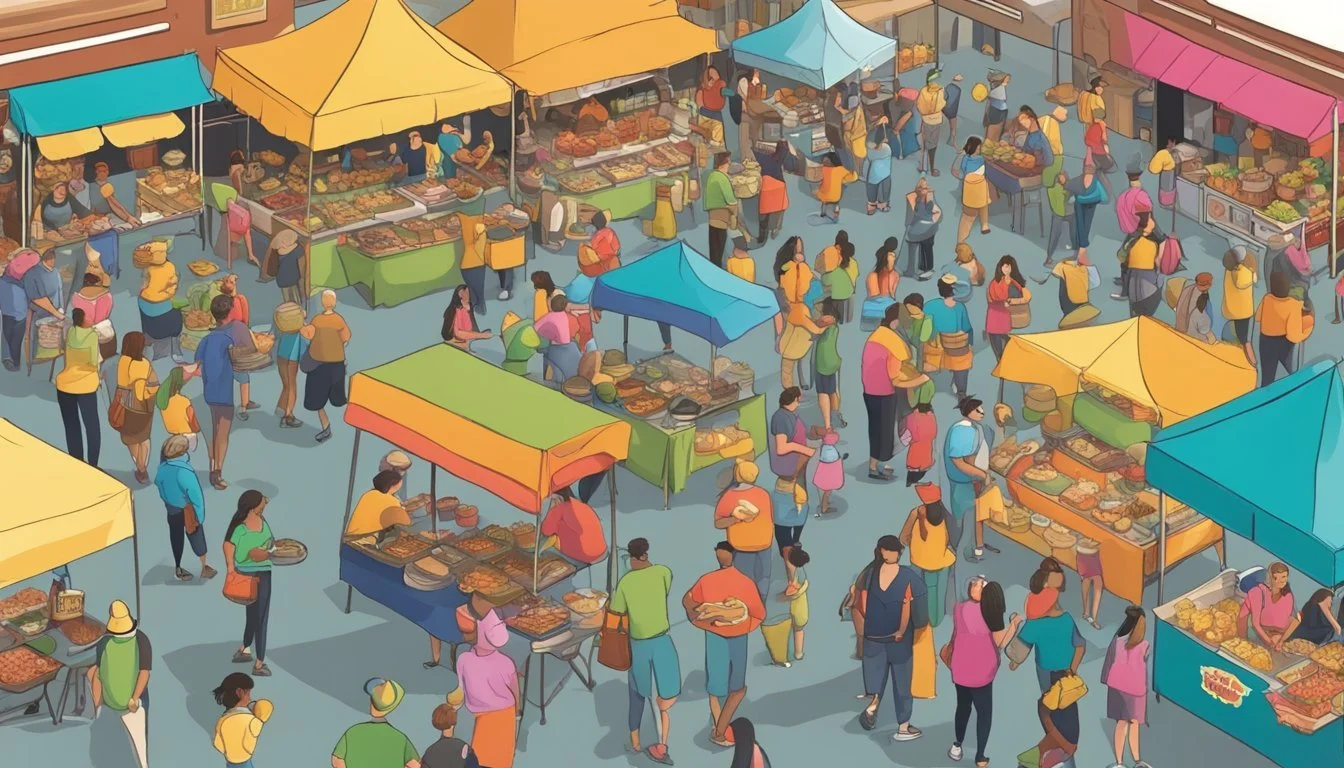Arizona Food Challenges
Tackling the Grand Canyon State's Biggest Eats
Arizona offers a smorgasbord of food challenges that beckon the brave and the hungry. From towering burgers to spicy wings, the Grand Canyon State has a variety of culinary gauntlets for food enthusiasts to conquer. These eating feats are not only about the size but often include a race against the clock, adding an extra layer of excitement to the dining experience. In numerous eateries across the state, participants can earn their place on the wall of fame—or simply walk away with a free meal—if they meet the arduous requirements.
At the heart of these challenges is a diverse range of venues, each presenting its unique take on the food challenge concept. In Phoenix, the intensity of the competition heats up with daunting dishes such as the multilayered deli sandwiches and the Matzo Ball Soup challenge at Chompie's, or enormous breakfast platters that have become the highlight at the Broken Yolk Cafe. Beyond the thrill and the spectacle, these challenges also reflect the bold flavors and expansive portions that are integral to Arizona's food culture.
Around the state, from New River to Mesa, restaurateurs have embraced the phenomenon, crafting food challenges that also reflect local tastes and ingredients. Perseverance, appetite, and a bit of strategy are key for those looking to triumph in the face of these delicious behemoths. Whether it's tackling a two-pound burger loaded with cheese, bacon (how long does bacon last?), and avocado as seen at the Roadrunner Restaurant & Saloon in New River, or enduring a platter heaped with BBQ at venues like Tom's BBQ, every challenge delivers a hearty dose of Southwestern hospitality with a side of competitive spirit.
Historical Background of Food Challenges in Arizona
In Arizona, food challenges have become a celebrated part of the state's culinary culture. These competitions often involve local individuals seeking to claim a spot on the coveted Wall of Fame or avoid the less desirable Wall of Shame. Throughout the years, such challenges have been a way to test one's appetite, endurance, and sometimes even one's culinary creativity.
The tradition of food challenges in AZ dates back to an era when local eateries began to look for ways to entice customers and create a buzz around their establishments. It's a practice that has evolved from simple oversized meal offerings to complex dishes that incorporate Arizona's rich flavors and hearty portions.
Common Elements:
Size: Oversized dishes are a signature element of these challenges.
Time: Participants are often pressed against the clock to finish their meals.
Variety: Challenges range from spicy food contests to mass quantity consumption.
Historically, diners who defeat these gastronomic giants are rewarded with their meal for free, a photo on the Wall of Fame, and sometimes additional prizes such as t-shirts or vouchers. The Wall of Shame, conversely, highlights those who have attempted but not completed the challenges. These walls serve not only as a record of individual victories and defeats but also as mementos that weave into the tapestry of Arizona's food challenge history.
Themed contests and challenges have also sprung from these origins, highlighting local cuisine like the formidable Roadrunner Restaurant's beefy burger challenge. Such events intertwine with state history, showcasing Arizona's adventurous spirit and love for hearty meals.
Overview of Notable Food Challenges
Arizona's food scene is not just about the flavors, but also the gargantuan portions and quirky culinary challenges. From massive steaks to towering burgers and dough-swaddled hot dogs, each challenge offers a unique thrill for daring foodies.
Steak Challenge
The 72-Ounce Steak Challenge beckons those who believe size matters in steakhouses. Participants are invited to devour a colossal 72-ounce steak, often accompanied by sides such as salad, shrimp cocktail, (What wine goes well with shrimp cocktail?) a roll with butter, and a baked potato. This herculean task is not for the faint of heart and has become a legendary test of human appetite.
Burger Challenge
Among the meaty mountains, the Burger Challenge often consists of multiple beef patties layered with an array of toppings, such as cheese, bacon, avocado, and eggs. Dining venues, like the Roadrunner Restaurant & Saloon, make this an event with timed challenges that, if completed, can earn the brave soul a free meal or even a spot on the wall of fame.
Corn Dog Challenge
Stepping into more whimsical territory, the Corn Dog Challenge pits diners against a forest of batter-wrapped, deep-fried hot dogs on a stick. These challenges are a test of both speed and capacity as competitors race to clear their plates of the crispy, golden treats.
Pizza Roll Challenge
Not to be overshadowed, the Pizza (What wine goes well with pizza?) Roll Challenge is a carb lover's delight, inviting participants to gorge themselves on oversized pizza rolls stuffed with gooey cheese and various toppings. These challenges can range from finishing a set number of rolls to completing a giant-sized roll within a time limit.
Sandwich Challenge
Last but not least, there's the Sandwich Challenge, which takes a variety of forms. One such challenge consists of Jewish Sliders, an homage to classic deli fare. Diners may face an array of mini sandwiches stacked with pastrami, Swiss cheese, and accompanied by sides like coleslaw and black and white cookies, as featured in Chompie's "A Day At The Deli" Challenge. Another formidable contender is the Colon Buster, weighing down the brave with a hefty combination of meats and toppings.
Famous Challenge Locations in Arizona
Arizona is home to numerous restaurants where adventurous eaters can challenge their appetites. Each establishment listed below offers a unique gastronomic quest that varies from colossal burgers to oversized pizzas.
Tom's BBQ
Tom's BBQ presents the Full House Challenge. Participants attempt to conquer a sizable platter consisting of a 12-inch hoagie filled with barbecue favorites and a mountain of fries, all within a set time limit for the chance to have the meal on the house.
Chompie’s
At Chompie’s, the "A Day at the Deli" Challenge is as hearty as it is legendary. Challengers face an array of traditional deli delights from oversized sandwiches to famous Black and White cookies. Success in this challenge often involves quick strategy and a resilient appetite.
Il Primo
Il Primo in Apache Junction dares patrons with its monstrous pizza challenge. Competitors work through a giant-sized pizza layered with toppings in hopes of earning a spot on the wall of fame and the satisfying victory of a free meal.
Venezia's Pizza
Similarly, Venezia's Pizzeria tests the will of pizza lovers with its Party Pizza Challenge. This Mesa favorite requires teams to tackle a giant, 24-inch pizza covered with their choice of toppings within a stringent time frame.
Lindy's on 4th
Finally, Lindy's on 4th is not for the faint of heart with its notorious burger challenges. These feats of culinary endurance feature towering stacks of patties and an array of creative toppings, providing a behemoth task for burger aficionados.
Cuisine Specialties in Challenges
In Arizona, food challenges capitalize on the state's bold flavors and portions, with meat-centric contests taking center stage, while vegetarian challenges offer a diverse range of ingredients for those seeking meat-free options.
Meat Lovers' Challenges
Arizona's renowned for its meat lovers' challenges, featuring local favorites like ham and brisket. For those who dare, the Steak Challenge often entails devouring a hefty cut of steak within a set time limit. At Roadrunner Restaurant & Saloon, challengers tackle a two-pound burger loaded with toppings, including bacon and avocado, striving to finish within 25 minutes.
Famous Challenges:
Steak: Conquer a massive steak solo.
Brisket & Bacon: Feast on smoked meats (What wine goes well with smoked meats?) with gusto.
Vegetarian Options
Contrary to the meat-heavy reputation, several Arizona food challenges cater to vegetarians, with dishes highlighting ingredients like avocado and bell peppers. These contests are no less challenging, requiring speed, appetite, and determination to complete. Creative concoctions make use of the versatile avocado in ways that go beyond the typical guacamole.
Top Contests:
Avocado Extravaganza: Avocados feature prominently in multiple courses.
Pepper Pyramid: A test of both capacity and spice tolerance with bell peppers.
Tips and Strategies for Conquering Food Challenges
When attempting food challenges—such as those made popular by the television show Man v. Food—strategists and competitive eaters alike understand that success hinges on more than just appetite. Preparation, technique, and a clear strategy are vital components in conquering these gastronomic feats.
Preparation is crucial. They recommend to increase stomach capacity gradually over time, ensuring their body can accommodate the volume of food presented in these challenges. Hydrating well in advance is also advised, as it can help stretch the stomach. However, one should strike a balance to avoid bloating.
Techniques:
Pace: They often start quickly to maximize eating in the beginning when hunger is greatest and only slow down as necessary.
Food Order: They might opt to consume proteins first, as they can quickly become difficult to digest, leaving carbohydrates and easier-to-eat items for later.
Strategy during the challenge is equally important. They break down the food into manageable pieces and use specific strategies for winning food challenges, such as altering bite sizes and chewing methods to minimize fatigue. They avoid carbonated beverages which can lead to feeling full prematurely.
A successful food challenger knows their limits and listens to their body's signals to avoid any potential health risks. They know this is not just about eating but also about strategy and understanding the mechanics behind competitive eating.
Health Considerations and Best Practices
In facing Arizona's food challenges, one must emphasize health and safety in the context of nutrition and public guidelines. Ensuring the availability of nutritious food is crucial. They advocate for policies that prioritize the public's health and the environment, supporting a sustainable food system.
Key Guidelines:
Balanced Diet: A diet rich in fruits, vegetables, and whole grains should be encouraged.
Food Safety: Strict adherence to food handling and preparation standards to prevent contamination and foodborne illnesses.
Sustainable Practices: Support and implementation of sustainable farming and food distribution practices that conserve resources and mitigate climate impact.
Nutrition Considerations:
Accessibility: Efforts to enhance mapping and visibility of local food system players can make nutritious options more accessible.
Education: Cultivating food-aware communities through education on healthy eating is fundamental.
Best Practices:
Sustainable Funding:
Explore and establish sustainable funding sources for marketing campaigns promoting locally grown foods.
Community Engagement:
Collaborate with local producers, suppliers, and institutions like schools and food banks to bolster the food system.
Arizona's statewide involvement is manifest in initiatives like Climate SMART (Specific Management for Arizona Resilience and Transformation) Agriculture Best Management Practices, demonstrating a commitment to climate-smart food crop strategies.
It is recommended that entities across Arizona commit to these practices and guidelines to address food challenges effectively.
Community and Events
In Arizona, the food community thrives not only on the flavors and traditions of the Southwest but also on the spirit of competition and celebration. With events that range from local food festivals to national competitive eating contests, Arizonans have carved out a niche that attracts both local food enthusiasts and competitive eaters alike.
Competitive Eating Communities
Competitive eating in Arizona has a passionate following, with communities forming around the excitement and prowess of consuming large quantities of food in record time. These groups often meet to practice, share strategies, and celebrate new records or personal bests. Hall of Fames exist to honor those who have shown exceptional skill and dedication to this unique sport, providing recognition and encouraging others to join the competitive eating circuit.
Annual Food Challenge Events
Annual food challenge events are a highlight in the Arizona culinary calendar. They showcase a wide array of culinary skills and attract food lovers and competitive eaters. Events such as the Arizona Food Summit invite stakeholders from various sectors to address food security and nutrition challenges, while also featuring competitive eating as part of the festivities. These gatherings not only celebrate the state's vibrant food scene but also focus on critical issues like sustainability, local farming, and community engagement in food systems.
Food Challenge Rewards and Recognition
In Arizona, food challenges come with various rewards for those who emerge victorious. Diners who conquer a food challenge may receive a free meal, such as at the Roadrunner Restaurant & Saloon, where they can gain not only a free meal but also a commemorative t-shirt. Recognition also comes in the form of placement on the establishment's Wall of Fame, celebrating the gustatory feats of diners for all to see.
Limited-Time Recognition: Some challenges offer limited-time notoriety for winners. This could mean a temporary feature on the restaurant's social media or a special place on the menu.
Monetary Rewards: A select few competitions provide monetary incentives or tabs at the bar, such as a $50 Tab at the Bar, to sweeten the deal for participants.
For those who try but fail to complete the challenge, there might be a spot reserved on the oft-humorous Wall of Shame. It's a light-hearted way to acknowledge the attempt and add to the challenge's community culture.
Participants should be aware that food challenges are typically:
Challenging: They can involve consuming large quantities of food or particularly spicy items.
Time-Bound: Most challenges have strict time limits within which to complete the task.
Rule-Governed: There are typically specific rules on what constitutes successful completion of the challenge.
Finally, food challenges aren't just about the individual; they are often witnessed by other diners, creating an atmosphere of collective anticipation and excitement. Successful challengers bask not only in the tangible rewards but also in acclaim from fellow food enthusiasts.
Legal and Ethical Considerations of Food Challenges
Food challenges in Arizona not only involve logistical and supply issues but also extend into the realm of legal and ethical responsibilities. Entities engaged in food distribution and policy-making must navigate a complex landscape of guidelines and regulations to promote equitable access to food resources and address food insecurity.
Guidelines: They are essential for ensuring that food distribution is conducted fairly and safely. For example, the Arizona Statewide Food Action Plan 2022-2024 outlines initiatives towards enhancing local food system visibility and securing sustainable funding for Arizona-grown food promotion.
Regulations: These are more rigorous and legally binding compared to guidelines. They encompass food safety standards, distribution protocols, and financial reporting requirements. Compliance with regulations such as the USDA’s National Organic Program is critical for maintaining the integrity of the food system.
Ethics: Ethical considerations in food challenges revolve around the fair allocation of resources, especially during emergencies. Ethical frameworks, as mentioned in literature on food insecurity, emphasize compassion, opportunity creation, addressing essential needs, and promoting knowledge and empathy. Moreover, during public health crises, Arizona faces dilemmas related to the ethical allocation of scarce food resources, such as during the COVID-19 pandemic.
In these domains, it is crucial for policymakers, food distributors, and businesses to stay informed and adapt to evolving challenges. They have the responsibility to act within legal constraints while also honoring ethical imperatives to safeguard public welfare and promote food justice.










